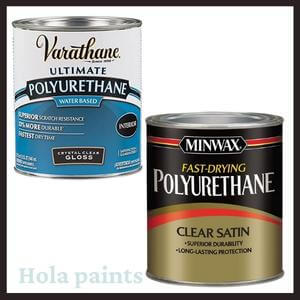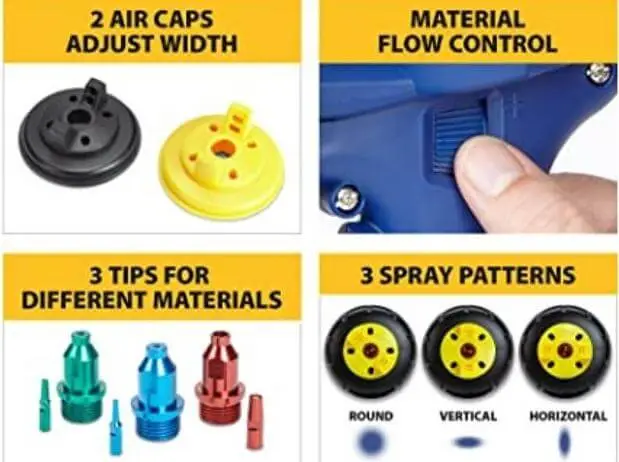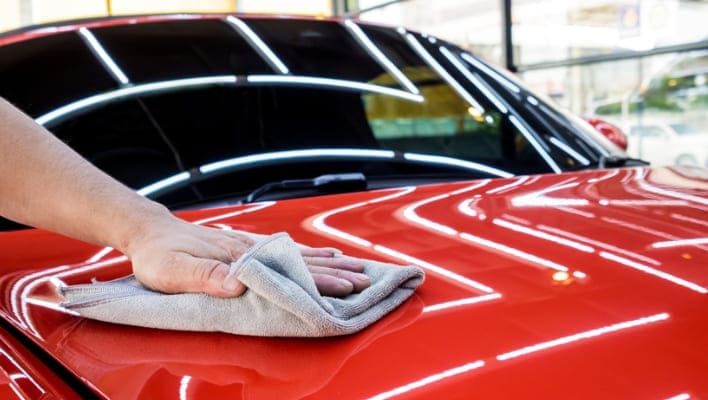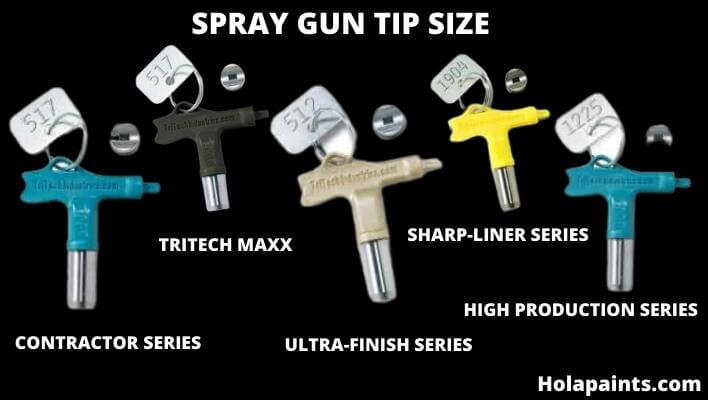Did you feel disappointed when you noticed brush marks or roller fibres on your final coat of polyurethane even after you applied a perfect finish? And you may wonder, as the spraying paint gives a lovely, smooth finish, will it work similarly to polyurethane? Therefore, a natural question would be, How to spray polyurethane?
A polyurethane layer is a liquid plastic that, once dry, forms a tough and durable layer that can protect various surfaces, like a polyurethane coating that protects wood from moisture damage. Therefore, if you have decided to spray polyurethane for your upcoming project, check out our complete guide below!
Table of Contents
- Can you spray polyurethane with a spray gun?
- 1- Choosing The Right Sprayable Polyurethane
- Choosing Oil-Based Polyurethane versus Water-Based Polyurethane
- * Can You Spray Water based Polyurethane?
- * Can You Spray Oil based Polyurethane?
- 2- Spray Polyurethane Dry Time
- 3- Finishing Touch
- 4- Work Environment
- 5- A Final Touch-Up
- 6- Cost-effective
- How to Spray Polyurethane?
- 1- Prepare Your Work Area
- 2- Sand The Surface
- 3- Setting Up The Sprayer
- Spray Tip Chart of Medium Material Thickness
- 4- Thinning Polyurethane To Spray
- *What is the right amount of thinning for spraying polyurethane?
- 5- A Cleaning And Drying Process
- What is the purpose of Using polyurethane?
- Spray polyurethane vs. brush on
- Using a brush to apply polyurethane has some drawbacks
- Finicky Finish
- Difficult to Apply
- Not desirable Look
- Best Way To Spray Polyurethane Finish
- How to spray water-based polyurethane?
- Tips to spray polyurethane with HVLP Wagner or Airless Sprayer
- Conclusion on How to Spray Polyurethane!
- FAQs on How To Spray Polyurethane?
- Can polyurethane be sprayed?
- Do you need thinning polyurethane to spray?
- How to thin polyurethane for spraying?
- What pressure are you using to spray polyurethane?
- Can airless sprayers be used for polyurethane?
- Is it possible to spray polyurethane with a pump sprayer?
Can you spray polyurethane with a spray gun?

Yes, It is easier to spray polyurethane since it requires no precise technique. Using a paint sprayer to spray polyurethane delivers a beautiful finish coat that adds beauty to everything from floors to laminate furniture and cabinets. Also, it can add durability to any wooden surface.
Most commonly, you will be looking for an Airless spray gun, an HVLP sprayer, or a conventional spray gun. An airless sprayer is the best option when it comes to the highest production. An HVLP spray gun will save you money and help to apply polyurethanes or other thinner coatings well.
Plus, conventional spray guns are usually the most cost-effective method of spraying polyurethanes or paint.
Note: Simply read the instructions and thin the paint accurately for spraying polyurethanes with pump sprayers.
Among the most common options are pressure and gravity guns. The heavier body coating of polyurethane may require a pressure-fed spray gun. However, spraying polyurethane requires a few extra steps but will result in a more attractive finish and fewer mistakes.
The best way to spray polyurethane is presented in this step-by-step guide. We’ll cover the preparation and application steps throughout this process, so there’s no need to worry about spraying polyurethane.
Are you interested in finding out more about polyurethane vs lacquer?
1- Choosing The Right Sprayable Polyurethane

You should consider several factors when choosing spray polyurethane for your project. The kind of spray you select will affect the drying time and the final result.
Both types of polyurethane offer good looks and are excellent in their way, but they have different advantages and properties. So it is essential to decide whether to use an oil-based polyurethane or water-based polyurethane spray.
You can spray oil-based polyurethane like Minwax polyurethane and water-based polyurethane like Varathane polyurethane.
Choosing Oil-Based Polyurethane versus Water-Based Polyurethane
* Can You Spray Water based Polyurethane?
No doubt, Water-based poly tends to be more transparent than oil-based polyurethane. Water-based poly produces fewer toxic fumes and volatile organic compounds than oil-based polyurethane, making them better for the environment. However, water-based polyurethanes are less durable than oil-based polyurethane.
Learn how to add tint in water or oil based polyurethane!
* Can You Spray Oil based Polyurethane?
Yes, DIY furniture looks more beautiful when coated with oil-based polyurethane, which is not the case with water-based polyurethane. Also, you can spray polyurethane for wood. Water-based polyurethanes are best for lighter woods, while oil-based ones generally enhance the color of darker woods. In fact, you can also apply polyurethane for DIY painting football helmet.
2- Spray Polyurethane Dry Time
Water-based polyurethanes dry faster than oil-based polyurethanes, so you should choose the ones that suit your work best depending on your needs and preference. Water-based Polyurethane sprays take two hours to dry, and they can be recoated and cleaned with water whereas you will need five to twelve hours for oil-based polyurethane to dry completely.
Even with fast-drying oil-based ones, the fastest it takes is four hours. You only have one choice if you have short of time and need to complete your project quickly.
3- Finishing Touch
When it comes to the finishing look of your polyurethane coating, you have to choose between a water-based or oil-based spray. Polyurethanes based on water are thinner and, as a result, require more coats whereas oil-based polyurethanes require fewer coats because of their thicker consistency for finishing.
Thus, the finishing effect of oil-based polyurethane is better than Water-based polyurethanes.
Helpful Resource: Discover how polyurethane and wax differ in terms of durability and the aesthetic impact they have on your wood surfaces.
4- Work Environment
The two types of Polyurethanes require special working conditions for optimum performance. Water-based polyurethane dries fast so that you can use it anywhere. On the other hand, you should use oil-based polyurethanes in a clean environment because they may take time to dry.
In case, when oil-based polyurethane is not used in a clean environment, insects and dust will stick to the surface over time and reduce the quality of the finish.
5- A Final Touch-Up
A water-based polyurethane usually requires two or three touch-ups after spraying. So, it is necessary to give a second coat to the surface once it has dried to achieve a good finish that eventually improves the surface’s quality.
However, oil-based polyurethanes perform best in this area. With its first coat, oil-based polyurethanes give the surface a nice shine and appearance and do not require additional coats to provide protection.
6- Cost-effective
The most important consideration is cost. Oil-based poly will be less expensive than water-based poly. Thus, if you are concerned about your budget, it is best to try oil-based polyurethanes.
How to Spray Polyurethane?
This step-by-step guide will be beneficial when spraying polyurethane paint for wooden or other surfaces. Take note of the following steps before proceeding.
1- Prepare Your Work Area
Organizing your work area should be your first concern. Make sure that the working room is clean before beginning your work. It is necessary to spray the material or any surface in a clean space. In the past few months, I learned a great way to keep an environment dust-free. I’m talking about the Home Right spray shelter.
In the spray shelter, you can prevent overspray from nearby objects, and dust and debris from getting on your furniture. You can also use the spray shelter to paint furniture. Furthermore, keep all the things you need for spraying within reach, but not too close.
2- Sand The Surface
Preparing the surface for polyurethane paint spray is another important step. You should have a clean, dirt-free surface. If necessary, wipe the surface with a clean cloth before spraying. You can sand the project surface lightly with 220 grit sandpaper before applying any stain or polyurethane to get a quality finish.
3- Setting Up The Sprayer
Spraying polyurethane in the right amount is the key to success for your project. In this regard, you need a quality sprayer with an adjustable knob that allows the controlled amount of product to flow through the paint sprayer. Plus, it would be a bonus if the paint sprayer came with multiple spray tips just like Home Right Super Finish Max sprayer. This spray gun comes with three spray tips.

The red tip sprays latex paint and primer with a 10″-12″ spray pattern, ideal for walls, ceilings, decks, and fences.
With the blue tip, you can spray stain and polyurethane on furniture with a 1″-6″ spray pattern. I used this tip to paint furniture. Plus, an included wrench makes installing the tip easy.
With the green tip, latex paint, chalk paint, and milk paint can be sprayed in a 1″-6″ spray pattern, which is also helpful for painting furniture.
Spray Tip Chart of Medium Material Thickness
| Spraying Material | Spray tip size |
| Lacquer (water based) | 012 – 014 |
| Oil-based Enamels | 013 – 015 |
| Polyurethane | 013 – 015 |
| Low VOC varnish | 013 – 015 |
| Solid Stain | 013 – 015 |
| Primer Latex | 015 – 017 |
| Clear Acrylics | 012 – 014 |
| Latex acrylic | 013 – 015 |
TEST:
It’s a good idea to test the amount of spray on a drop cloth or cardboard box first, and then adjust the dial until it is as you want it.

4- Thinning Polyurethane To Spray
Sprayable polyurethane must be appropriately prepared before starting spraying.
The thicker coats of polyurethane may require thinners to make it easier to spray.
If you are unsure whether you need a thinner or skip this thinning step, then apply the paint without adding thinner and see if you like the final results.
For this purpose, if you notice large clots or an orange peel effect after spraying the material without thinner, you may want to either add thinner or try a slightly higher air pressure setting.
*What is the right amount of thinning for spraying polyurethane?
Polyurethane needs to be at least 5 to 10% thinner before spraying. Adding thinner is usually determined by referring to the coatings technical data sheet, which will list appropriate thinners or cleaners that you can often use for thinning purposes.
How do you thin polyurethane?
It is possible to thin polyurethane by mixing oil-based poly with paint thinner and water-based poly with water.
Base Coat
One part of paint thinner can be mixed with two parts of polyurethane for the base coat.
Additional Coats
My sprayer container first needs to be filled with polyurethane before I apply additional coats. After adding the polyurethane to the sprayer container, I thin it by 5%.
5- A Cleaning And Drying Process
Let your paint dry. After the paint has dried, clean the painted surface with water.
Before proceeding further, let’s find out what polyurethane is used for!
What is the purpose of Using polyurethane?
Polyurethane protects DIY furniture by creating a clear, durable layer. It can be used for doors, floors, windows, cabinets and woodworking projects.
Spray polyurethane vs. brush on

If you apply poly using a paintbrush, you will quickly see the delicate lines left by the brush bristles.
So, if you want to apply a second layer of polyurethane, you must sand it lightly to remove brush strokes, dust it thoroughly, and sand it again.
Plus, the brush needs to have the perfect angle and be high-quality. With each poly application, you’ll need a feather-light touch to make your brush strokes less noticeable.
Polyurethane can be applied without brush strokes using a paint sprayer.
Additionally, you can apply lighter coatings with Wagner sprayers or Airless sprayers so that each layer dries much faster.
Using a brush to apply polyurethane has some drawbacks
When it comes to DIY furniture, I usually don’t prefer polyurethane for a few reasons. However, I’m sharing my personal experience of DIY projects.
A flawless finish starts with proper sanding. After that, I inspect the wooden piece and fill any gaps, nail holes or cracks with DIY wood filler. Now, it’s time to apply the wood stain.
The Rust-Oleum Ultimate Wood Stains are my absolute favorite. I prefer to use Rust-Oleum stains because of the single coat coverage, the quick drying time, and the beautiful, deep colors.
Here are the few disadvantages of using polyurethane.
Finicky Finish
The first step in applying polyurethane is to ensure that the area is dust-free. According to the instructions, you will find that air bubbles are also a problem with polyurethane. Avoid shaking the poly can or wiping your brush on its rim because you’ll introduce bubbles into the poly that will be transferred to the surface.
Dry bubbles will leave bumps in your finish. Getting rid of bubbles requires sanding them.
Polyurethane drips can be just as problematic as air bubbles. You must correct drips right away, before they dry. If drips are left to dry, they will be removed with a razor blade and sanded. This is another step that will consume your time and energy.
Difficult to Apply
Using a brush to apply polyurethane is difficult. If you’re brushing poly, you need to make long, even strokes. If your brush touches an area where the poly is drying, you may pull the finish, resulting in bumps after it dries. It is necessary to sand these bumps in order to smooth the finish.
Not desirable Look
With a brush, poly can sometimes look like plastic, but it provides a clear, durable finish. Polyurethane does not penetrate wood. Looking closely, you can see that it just rests on top.
What’s the Best Way to Apply Polyurethane? (Personal Experience)
My opinion of polyurethane has been changed after using paint sprayers.
My Home Right sprayer helped me spray primer and two coats of paint within a few hours.
As I thoroughly read the instructions for the Home Right Super Finish Max sprayer, I realized it can spray polyurethane as well. It’s my first-time hearing about spraying polyurethane.
I was thinking like, Is this the answer to my earlier concerns about polyurethane? To test it out, I applied it to my wooden cabinets.
Guess what, there is an amazing finish on the wooden cabinets. I was really pleased.
The sprayer made it easy to apply polyurethane without fear of bubbles, and since it applied thin coats, the finish did not appear plastic. The sprayer is always my go-to tool for applying poly!
Best Way To Spray Polyurethane Finish
It is also essential to use good techniques to get a good finish. Consider your application technique, equipment, polyurethane characteristics, and where you spray to ensure that your coat is applied efficiently and looks better.
When spraying polyurethane, you should aim to apply thin coats for the best results. To get a smooth finish, smaller spraying fluid nozzles 1.0 – 1.4 mm typically or air assist airless tip sizes are needed.
For spray guns, you will generally hold the gun closer to the product surface, while air assists airless spray guns need to be held farther away.
It is recommended to sand between each coat of polyurethane (usually with about 220 Grit sandpaper) as this will help create a surface that will adhere to the next.
If you want polyurethane to be protective, you should increase its thickness through multiple thin coats.
How to spray water-based polyurethane?
There are some benefits of switching from solvent-based polyurethane to water-based polyurethane, such as a lower fire hazard and odor and minimal environmental impact. This change cannot be easy since water-based polyurethane is challenging to apply.
Although we have found that pulling the release on the gun and covering the area while moving the gun is pretty similar, some distinct differences can create problems that are potential barriers to switching. Thus, we have provided all the solutions to your issues below:
- Before you start spraying, you need to be careful not to stain the surface.
- In cold weather, water-based coatings don’t atomize as efficiently. For this reason, you can use air-assisted airless and airless sprayers.
- A water-based coating can even be thinned with water to improve atomization.
- A major challenge in converting to water-based finishes is cleaning the spray guns and equipment, and it is best to disassemble your guns and scrub every part with a brush afterward. Plus, spray gun manufacturers often sell a gun-cleaning solvent.
Tips to spray polyurethane with HVLP Wagner or Airless Sprayer
The process of spraying polyurethane can be fast and easy, but it can also be painful if you don’t know how to handle it properly. So, following are some tips for ensuring a smooth finish:
- Make sure not to get drips and runs on vertical surfaces when you are applying polyurethane.
- Do not spray more than one thin coat until it is completely dry.
- In case of runs, use a sharp razor blade to remove them gently.
- Be sure to spray in clear light, so you don’t overspray or miss any areas of the piece.
- Before you begin, prepare all your safety and cleaning tools.
Conclusion on How to Spray Polyurethane!
All in all, we are hopeful that the topic How to spray polyurethane is now crystal clear to you. Also, you can ensure that your coating will apply efficiently and look better by considering your application equipment, technique, where you spray, and the properties of the polyurethane you want to use. Now, you all know that a good way of achieving a professional-looking finish on wooden surfaces is to spray polyurethane.
Good Luck!
FAQs on How To Spray Polyurethane?
Can polyurethane be sprayed?
Yes, Absolutely. Polyurethane spray finish is durable and attractive, and it looks great on all wooden surfaces, from furniture to floors. There are numerous spray polyurethanes available in which spray cans and paint sprayers are the most popular ways to apply polyurethane.
Do you need thinning polyurethane to spray?
The polyurethane coating possesses long-lasting durability, meaning the liquid itself is pretty thick and honey-like. So, a thinner will be necessary before spraying your polyurethane. It is best to start by testing the polyurethane without thinner to see how it feels, then add thinner if needed. In short, The thinner the polyurethane, the better the finish.
How to thin polyurethane for spraying?
It is necessary to mix oil-based poly with paint thinner, whereas water-based poly is mixed with water. You can make the base coat by mixing two parts polyurethane with one part paint thinner. Turpentine, paint thinner, mineral spirits, and even water works well for thinning polyurethane. Painters often use turpentine, a strong-smelling substance, to thin polyurethane.
What pressure are you using to spray polyurethane?
The spray pressure for the base coat should be between 26-29 PSI. Also, It’s nice to spray a clear coat at a 2-3 psi pressure to get better atomization and flow out.
Can airless sprayers be used for polyurethane?
The majority of paint sprayers can be used with polyurethane, including airless sprayers. Make sure to clean the sprayer thoroughly before and after use, and you should use the correct viscosity of polyurethane.
Is it possible to spray polyurethane with a pump sprayer?
You can spray polyurethane with pump sprayers. Applying a thin coat of polyurethane (as thin as possible) will give you the best finish. It means using smaller fluid nozzles (1-1.4mm) or making a quick pass over the surface of the product.

Jennifer Marie
Jennifer Marie is a general contractor with over the years of experience in home remodeling, DIY projects, and commercial painting projects. Her experience includes working with paint sprayers, painting tools, and other painting supplies. You can follow her on Facebook.


